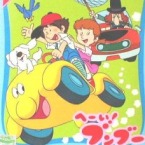
Animation is a filmmaking technique by which still images are manipulated to create moving images. In traditional animation, images are drawn or painted by hand on transparent celluloid sheets (cels) to be photographed and exhibited on film. Animation has been recognized as an artistic medium, specifically within the entertainment industry. Many animations are computer animations made with computer-generated imagery (CGI). Stop motion animation, in particular claymation, has continued to exist alongside these other forms.

Anime is hand-drawn and computer-generated animation originating from Japan. Outside Japan and in English, anime refers specifically to animation produced in Japan. However, in Japan and in Japanese, anime describes all animated works, regardless of style or origin. Many works of animation with a similar style to Japanese animation are also produced outside Japan. Video games sometimes also feature themes and artstyles that can be considered as "anime".
Original video animation, abbreviated as OVA and sometimes as OAV, are Japanese animated films and series made specially for release in home video formats without prior showings on television or in theaters, though the first part of an OVA series may be broadcast for promotional purposes. OVA titles were originally made available on VHS, later becoming more popular on LaserDisc and eventually DVD. Starting in 2008, the term OAD began to refer to DVD releases published bundled with their source-material manga.
Animation in the United States in the television era was a period in the history of American animation that slowly set in with the decline of theatrical animated shorts and the popularization of television animation that started in 1959, reached its peak during the 1970s, and ended around 1986. This era is characterized by low budgets, limited animation, an emphasis on television over the theater, and the general perception of cartoons being primarily for children. Due to the perceived cheap production values, poor animation, and mixed critical and commercial reception, this era is sometimes referred to as the dark age of American animation by critics.
An animated series is a type of animated television works with a common title, usually related to one another. These episodes should typically share the same main heroes, some different secondary characters and a basic theme. Series can have either a finite number of episodes like a miniseries, a definite end, or be open-ended, without a predetermined number of episodes. They can be broadcast on television, shown in movie theatres, released direct-to-video or on the internet. Like other creative works, animated series can be of a wide variety of genres and can also have different target audiences: both males and females, both children and adults.
The history of anime can be traced back to the start of the 20th century, with the earliest verifiable films dating from 1912. Before the advent of film, Japan already had a rich tradition of entertainment with colourful painted figures moving across the projection screen in utsushi-e (写し絵), a particular Japanese type of magic lantern show popular in the 19th century. Possibly inspired by European phantasmagoria shows, utsushi-e showmen used mechanical slides and developed lightweight wooden projectors (furo) that were handheld so that several performers could each control the motions of different projected figures.
While the history of animation began much earlier, this article is concerned with the development of the medium after the emergence of celluloid film in 1888, as produced for theatrical screenings, television and (non-interactive) home entertainment.

Dogtanian and the Three Muskehounds is a Spanish-Japanese children's animated television series that adapts the classic 1844 Alexandre Dumas story of d'Artagnan and The Three Musketeers, produced by Spanish studio BRB Internacional with animation by Japanese studio Nippon Animation, that was first broadcast on MBS in Japan in 1981–82.

Bumpety Boo is an anime children's television series produced by the Nippon Animation company from 1985 to 1986. The series consists of 130 10-minute episodes, distributed as 43 half-hour segments.

King Kong, commonly referred to as The King Kong Show, is an American-Japanese animated series produced by Videocraft International and Toei Animation. ABC ran the series in the United States on Saturday mornings between September 10, 1966, and August 31, 1969. It is the first anime-based series produced in Japan for an American company.

The Adventures of the Little Prince is an anime series based on the book by Antoine de Saint-Exupéry. Made by the animation studio Knack Productions, the series, originally titled The Prince of the Stars: Le Petit Prince, aired in Japan on the TV Asahi network from July 1978 to March 1979. Dubbed into English, the series premiered in the United States in 1985 on Nickelodeon and was rerun through June 1, 1985 to December 29, 1989. It was also broadcast on TVOntario throughout the 1980s beginning in 1985, a station that would later pick up the dub of the 2010 French adaptation. Yoshikazu Yasuhiko, of Mobile Suit Gundam fame, was involved in this series as a director.
Anime-influenced animation or Animesque is a type of non-Japanese works of animation that are similar to or inspired by anime that is not made in Japan. Generally, the term anime refers to a style of animation originating from Japan. As Japanese anime became increasingly popular, Western animation studios began implementing some visual stylizations typical in anime—such as exaggerated facial expressions and "super deformed" versions of characters.

Kappa Mikey is an American animated comedy television series created by Larry Schwarz. Animated by Schwarz's production company, Animation Collective, The series ran from February 25, 2006 to September 20, 2008, with repeats until November 29, 2010. 52 22-minute episodes were produced across two seasons.

An animation studio is a company producing animated media. The broadest such companies conceive of products to produce, own the physical equipment for production, employ operators for that equipment, and hold a major stake in the sales or rentals of the media produced. They also own rights over merchandising and creative rights for characters created/held by the company, much like authors holding copyrights. In some early cases, they also held patent rights over methods of animation used in certain studios that were used for boosting productivity. Overall, they are business concerns and can function as such in legal terms.
Anime is hand-drawn and computer-generated animation originating from Japan. However, Outside of Japan and in English, anime refers specifically to the animation produced exclusively in Japan. However, in Japan and in Japanese, anime is generally described as all animated works, regardless of style, type or origin.

These lists of animated feature films compile animated feature films from around the world and are organized alphabetically under the year of release. Theatrical releases as well as made-for-TV (TV) and direct-to-video (V) movies of all types of animation are included. Currently, the lists don't recognize one release form from another.









